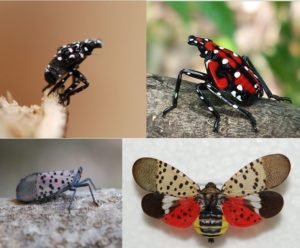Spotted Lanternfly
go.ncsu.edu/readext?653680
en Español / em Português
El inglés es el idioma de control de esta página. En la medida en que haya algún conflicto entre la traducción al inglés y la traducción, el inglés prevalece.
Al hacer clic en el enlace de traducción se activa un servicio de traducción gratuito para convertir la página al español. Al igual que con cualquier traducción por Internet, la conversión no es sensible al contexto y puede que no traduzca el texto en su significado original. NC State Extension no garantiza la exactitud del texto traducido. Por favor, tenga en cuenta que algunas aplicaciones y/o servicios pueden no funcionar como se espera cuando se traducen.
Português
Inglês é o idioma de controle desta página. Na medida que haja algum conflito entre o texto original em Inglês e a tradução, o Inglês prevalece.
Ao clicar no link de tradução, um serviço gratuito de tradução será ativado para converter a página para o Português. Como em qualquer tradução pela internet, a conversão não é sensivel ao contexto e pode não ocorrer a tradução para o significado orginal. O serviço de Extensão da Carolina do Norte (NC State Extension) não garante a exatidão do texto traduzido. Por favor, observe que algumas funções ou serviços podem não funcionar como esperado após a tradução.
English
English is the controlling language of this page. To the extent there is any conflict between the English text and the translation, English controls.
Clicking on the translation link activates a free translation service to convert the page to Spanish. As with any Internet translation, the conversion is not context-sensitive and may not translate the text to its original meaning. NC State Extension does not guarantee the accuracy of the translated text. Please note that some applications and/or services may not function as expected when translated.
Collapse ▲Spotted lanternfly (Lycorma delicatula) is an invasive planthopper native to Asia. It was first detected in the United States in Pennsylvania in 2014. Although this insect has not yet been found in North Carolina, the N.C. Department of Agriculture & Consumer Services has started a widespread campaign to educate citizens about this impending invasive pest. It is hoped that early detection and reporting can help reduce the spread of the lanternfly. This insect has a broad host range and poses a major threat to the North Carolina grape and orchard industries.
The spotted lanternfly has one generation per year and is able to overwinter in the egg stage. Egg masses look like blobs of silly putty. Females lay eggs on smooth surfaces, including metal. Spotted lanternflies are excellent hitchhikers because egg masses can be transported on train cars, lawn equipment, and shipping containers. Indications of a spotted lanternfly infestation are large areas of sooty mold growing on honeydew excreted by this insect. Although the host range is broad, spotted lanternfly does favor another invasive species, tree-of-heaven (Ailanthus altissima), which is commonly seen in disturbed sites and along roadsides. Tree-of-heaven is recognized by its large, pinnately compound leaves and prominent clusters of samaras (winged seeds). Visit NC State Extension’s spotted lanternfly resource page for more information.
The Master Gardener℠ volunteers of Union County will hold their February Fruit & Plant Sale on February 22, 2020, 10 a.m.–1 p.m. at the N.C. Cooperative Extension, Union County Center. Plants available will include fruit trees, blueberries, blackberries, native bare-root trees and shrubs, and others. This is a popular sale, so come early for the best selection. Master Gardener℠ volunteers will be on hand to answer your questions about growing fruit and other gardening questions.





